Polarization (waves)
In circular or elliptical polarization, the fields rotate at a constant rate in a plane as the wave travels, either in the right-hand or in the left-hand direction.[8] Polarization is an important parameter in areas of science dealing with transverse waves, such as optics, seismology, radio, and microwaves.Incoherent states can be modeled stochastically as a weighted combination of such uncorrelated waves with some distribution of frequencies (its spectrum), phases, and polarizations.In a more general formulation with propagation not restricted to the +z direction, then the spatial dependence kz is replaced by k→ ∙ r→ where k→ is called the wave vector, the magnitude of which is the wavenumber.Knowing the propagation direction (+z in this case) and η, one can just as well specify the wave in terms of just ex and ey describing the electric field.Even in isotropic media, so-called inhomogeneous waves can be launched into a medium whose refractive index has a significant imaginary part (or "extinction coefficient") such as metals;[clarification needed] these fields are also not strictly transverse.An extreme example is radially or tangentially polarized light, at the focus of which the electric or magnetic field respectively is entirely longitudinal (along the direction of propagation).Note that circular or elliptical polarization can involve either a clockwise or counterclockwise rotation of the field, depending on the relative phases of the components.The special cases of linear and circular polarization correspond to an ellipticity ε of infinity and unity (or χ of zero and 45°) respectively.The physical electric field, as the real part of the Jones vector, would be altered but the polarization state itself is independent of absolute phase.When considering light that is propagating parallel to the surface of the Earth, the terms "horizontal" and "vertical" polarization are often used, with the former being associated with the first component of the Jones vector, or zero azimuth angle.[17] Conversely, the two constituent linearly polarized states of unpolarized light cannot form an interference pattern, even if rotated into alignment (Fresnel–Arago 3rd law).In a vacuum, the components of the electric field propagate at the speed of light, so that the phase of the wave varies in space and time while the polarization state does not.As noted above, the instantaneous electric field is the real part of the product of the Jones vector times the phase factorwhere g1 and g2 are complex numbers describing the phase delay and possibly the amplitude attenuation due to propagation in each of the two polarization eigenmodes.Circular birefringence is also termed optical activity, especially in chiral fluids, or Faraday rotation, when due to the presence of a magnetic field along the direction of propagation.In addition to birefringence and dichroism in extended media, polarization effects describable using Jones matrices can also occur at (reflective) interface between two materials of different refractive index.When the right and left handed enantiomers of such a molecule are present in equal numbers (a so-called racemic mixture) then their effects cancel out.Apart from providing information on sources of radiation and scattering, polarization also probes the interstellar magnetic field via Faraday rotation.Polarizing sunglasses exploit this effect to reduce glare from reflections by horizontal surfaces, notably the road ahead viewed at a grazing angle.The Pfund sky compass was used in the 1950s when navigating near the poles of the Earth's magnetic field when neither the sun nor stars were visible (e.g., under daytime cloud or twilight).[38]: 67–69 The principle of liquid-crystal display (LCD) technology relies on the rotation of the axis of linear polarization by the liquid crystal array.That polarized light passes through the actual liquid crystal layer which may be organized in pixels (for a TV or computer monitor) or in another format such as a seven-segment display or one with custom symbols for a particular product.Displays based on this principle are widespread, and now are used in the vast majority of televisions, computer monitors and video projectors, rendering the previous CRT technology essentially obsolete.In a totally different sense, polarization encoding has become the leading (but not sole) method for delivering separate images to the left and right eye in stereoscopic displays used for 3D movies.However, circular polarization makes separation of the two images insensitive to tilting of the head, and is widely used in 3-D movie exhibition today, such as the system from RealD.Although now obsolete, CRT computer displays suffered from reflection by the glass envelope, causing glare from room lights and consequently poor contrast.Especially due to the presence of the ground, there are some differences in propagation (and also in reflections responsible for TV ghosting) between horizontal and vertical polarizations.The effect of free electrons in the ionosphere, in conjunction with the earth's magnetic field, causes Faraday rotation, a sort of circular birefringence.Sky polarization was thought to be perceived by pigeons, which was assumed to be one of their aids in homing, but research indicates this is a popular myth.
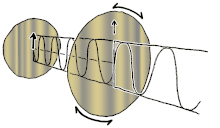



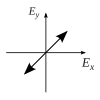
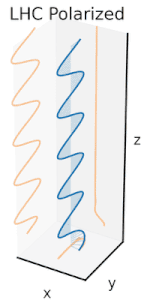
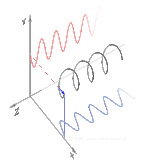

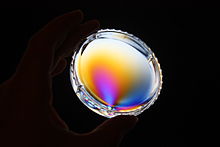
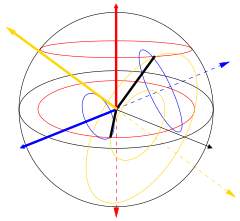

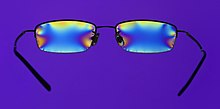




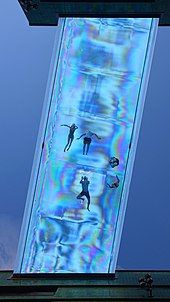

Polarizationtransverse wavesoscillationsguitar stringlongitudinal wavessound waveselectromagnetic wavesradio wavesgravitational wavesshear waveselectromagnetic waveelectric fieldmagnetic fieldlinear polarizationcircularelliptical polarizationright-handincandescent lampsunpolarized lightpolarizerbirefringencedichroismoptical activityquantum mechanicsstreams of particlesphotonsright handopticsseismologymicrowaveslaserstelecommunicationsplane waveswavevectorangular spectrumstochasticallydistributionspectrumhomogeneousisotropicnon-attenuatingplane wavecomplexphasorreal partsrefractive indexwavenumberangular frequencywave vectorcharacteristic impedanceimpedance of free spacedot productorthogonalJones vectorintensityanisotropicelectric displacementmagnetic flux densityelectric susceptibilitymagnetic permeabilitytensorSurface waveswaveguideoptical fibertransverse moderadiallyfluidsshear stressCircular polarizationquarter-wave platePolarization ellipseaxial ratiomodulusabsolute phaseinner productastronomyequatorial coordinate systemhorizontal coordinate systemplane of incidenceStokes parametersstrainphotoluminescencephotoelasticity tensorPoincaré spherevectoruncorrelatedincoherentlinearly polarizedcircularly polarizedinterference patternFresnel–Arago 3rd lawdepolarizerdegree of polarizationvacuumspeed of lightindex of refractiondiattenuationpropagation constantstransformationJones matrixdispersivephase factorphase delayeigenmodesunitary matrixbirefringentphase velocitiesphase differencedichroicHermitian matrixpolarizerswave plateschiralFaraday rotationrotationcalcitecrystalsErasmus Bartholinusextinction ratioFresnel equationsangle of incidenceBrewster's anglepolarized sunglassesengineeringcellophaneEllipsometry